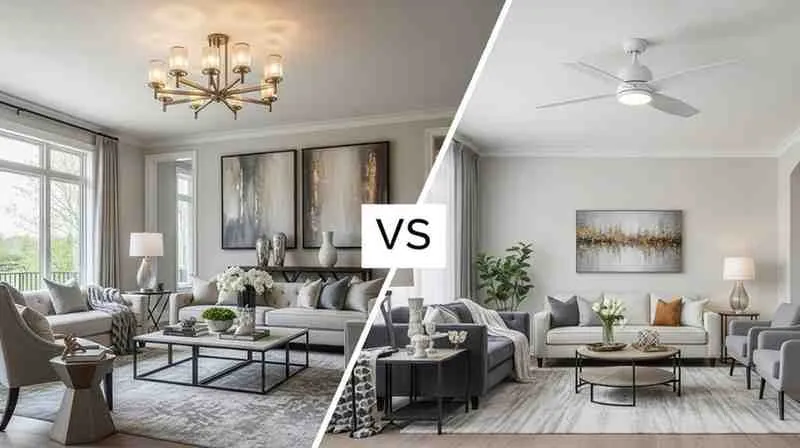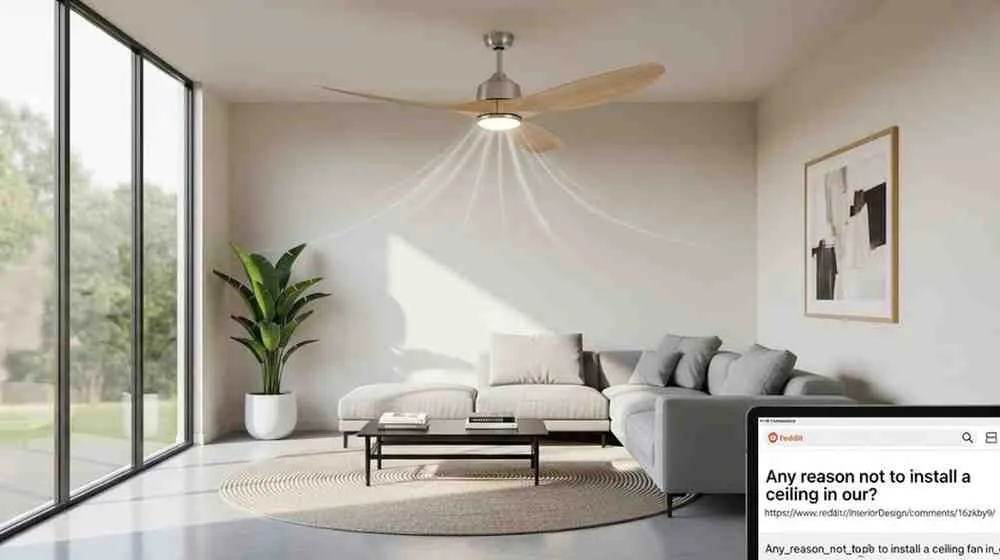Introduction: The Living Room Ceiling Fan Dilemma
You’re standing in your living room, looking up at that blank ceiling space, wondering if adding a ceiling fan would be a smart move or a design disaster. Maybe you’ve been binge-watching home renovation shows where designers rip out ceiling fans like they’re committing interior design crimes. Or perhaps you’re sweating through another summer, thinking there has to be a better way to circulate air without cranking the AC to maximum.Should You Install a Ceiling Fan in Your Living Room? A Complete Design & Functionality Guide.
Here’s the truth: the ceiling fan debate isn’t as simple as “yes” or “no.” It’s about understanding your specific space, your climate needs, your design aesthetic, and what modern ceiling fan technology can actually deliver in today’s homes.
In this comprehensive guide, we’ll explore everything you need to know about installing a ceiling fan in your living room. You’ll discover the honest pros and cons, learn which modern designs won’t sabotage your carefully curated aesthetic, understand the energy savings potential, and get expert recommendations for making the best choice for your space.
Whether you’re dealing with a small apartment living room or a sprawling open-concept great room, this guide will help you make an informed decision that balances comfort, style, and functionality.
The Modern Reality: Ceiling Fans Aren’t What They Used to Be
Let’s address the elephant in the room: ceiling fans have a reputation problem. For years, they’ve been associated with outdated, bulky designs featuring brass finishes, frosted glass shades, and those awkwardly angled blades that collect dust faster than they circulate air.
But here’s what’s changed dramatically in recent years.

The Evolution of Ceiling Fan Design
Modern ceiling fans now feature minimalist silhouettes, sculpted blades, and premium materials like wood, glass, or metal, placing them in an entirely different category from their predecessors. Today’s options include:
- Ultra-slim profiles that virtually disappear into the ceiling
- Bladeless designs that look more like modern art installations
- Integrated LED lighting with dimmable, color-adjustable features
- Whisper-quiet DC motors that won’t interrupt conversations or TV watching
- Smart home integration allowing control via smartphone or voice commands
- Premium finishes including matte black, brushed nickel, aged brass, and natural wood
The design community has taken notice. Contemporary ceiling fans with subtly incorporated light sources operate quietly, making them suitable even for design-focused spaces where every element matters.
Why Interior Designers Previously Avoided Ceiling Fans
Understanding the historical resistance helps explain why ceiling fans developed such a negative reputation:
- Bulky, disproportionate designs that dominated room aesthetics
- Poor-quality motors that rattled, wobbled, and created distracting noise
- Excessive lighting fixtures with multiple bulbs and busy glass shades
- Limited style options that rarely complemented contemporary interiors
- Installation quality issues leading to dangerous wobbling and electrical problems
The good news? Modern interior styles favor minimalism, and contemporary ceiling fans now reflect this simplicity, making them viable options even for the most design-conscious homeowners.
Understanding Your Living Room’s Specific Needs
Before deciding whether to install a ceiling fan, you need to evaluate your living room’s unique characteristics. Not all spaces benefit equally from ceiling fan installation.
Critical Factors to Consider
Room Size and Ceiling Height
For living rooms up to 400 square feet, fans with blade spans between 52 and 60 inches provide ideal airflow. Larger open-concept areas or great rooms exceeding 400 square feet require fans with blade spans of 60 inches or greater to move air effectively throughout the space.
Ceiling height is equally important. Fan blades should be a minimum of seven feet above the floor, and for optimal performance and safety, many experts recommend even greater clearance. If your living room has ceilings under 8 feet, you’ll need flush-mount or hugger-style fans that sit close to the ceiling surface.
Climate and Temperature Control Needs
Your geographical location and home’s existing climate control systems play a major role. During summer, ceiling fans spinning counterclockwise create a downdraft that keeps spaces cooler, while winter clockwise rotation creates an updraft that pushes warm air down, making them year-round comfort solutions.
Consider these climate-related questions:
- Does your area experience extended hot, humid summers?
- Do you have central air conditioning, or do you rely on window units?
- Are heating costs a concern during winter months?
- Does your living room get particularly stuffy or have poor natural airflow?
Existing Lighting Situation
Evaluate your current lighting setup. If your living room lacks adequate overhead lighting, fans with built-in lights can serve dual purposes, eliminating the need for separate fixtures. However, if you already have sufficient lighting from lamps, recessed fixtures, or a statement chandelier, a fan-only model might be more appropriate.
Design Aesthetic and Personal Style
Be honest about your design priorities. If you’ve invested significantly in creating a specific aesthetic—whether that’s minimalist Scandinavian, industrial loft, traditional elegance, or coastal casual—the ceiling fan you choose must complement rather than contradict that vision.

The Compelling Benefits: Why Living Room Ceiling Fans Make Sense
Let’s explore the concrete advantages that make ceiling fans worth serious consideration for many living rooms.
1. Significant Energy Efficiency and Cost Savings
This is where ceiling fans truly shine. Ceiling fans use less electricity than air conditioning and heating units, enhancing the efficiency of your climate control systems when used strategically.
The numbers tell an impressive story:
- Running a ceiling fan costs approximately $0.01 to $0.02 per hour
- Running central AC costs approximately $0.36 per hour on average
- When used with AC units, you can set thermostats at higher temperatures while remaining comfortable, potentially reducing cooling costs by 30-40% during summer months
The energy efficiency extends to winter as well. By redistributing warm air that naturally rises to the ceiling, ceiling fans help heating systems work less, extending their operational lifespan while reducing monthly utility bills.
2. Improved Air Circulation and Comfort
Beyond simple cooling, ceiling fans address a common problem in living rooms: stagnant air. Ceiling fans ensure proper air circulation throughout the room, keeping temperatures more consistent and creating a more comfortable environment for extended periods.
This matters particularly in:
- Open-concept living spaces where air tends to settle
- Rooms with limited window placement or natural cross-ventilation
- Homes with high or vaulted ceilings where temperature stratification occurs
- Living rooms that serve as primary gathering spaces for extended family time
Ceiling fans create a breeze effect that makes rooms feel cooler by several degrees, even without changing the actual temperature—a phenomenon known as the wind chill effect.
3. Versatile Year-Round Functionality
Unlike portable fans or window AC units that get stored away seasonally, ceiling fans provide value throughout the entire year. The reversible motor function transforms them from summer cooling solutions to winter heating helpers with a simple switch flip.
This versatility makes them particularly valuable in:
- Climates with distinct seasonal temperature variations
- Homes without optimal insulation
- Rooms with passive solar heating that can become overheated
- Spaces where maintaining consistent comfort matters year-round
4. Enhanced Home Value and Buyer Appeal
While not as impactful as kitchen or bathroom renovations, properly chosen ceiling fans can improve perceived home value by offering lower operating costs and better airflow, features that resonate with energy-conscious buyers.
Real estate professionals note that homes with modern, stylish ceiling fans often receive positive feedback during showings, particularly in:
- Warmer climates where cooling costs factor heavily into buying decisions
- Older homes where efficient climate control is a concern
- Properties marketed to environmentally conscious buyers
- Vacation or second homes where seasonal comfort matters
5. Reduced Dependence on HVAC Systems
Beyond immediate cost savings, ceiling fans offer a practical benefit that becomes apparent over time: reduced wear and tear on expensive HVAC equipment. By lessening the burden on air conditioning and heating systems, ceiling fans can extend the operational lifespan of these costly investments, potentially delaying replacement by years.
The Honest Drawbacks: When Ceiling Fans Don’t Work
Fairness demands we examine the legitimate concerns and disadvantages associated with living room ceiling fans.

1. Aesthetic Challenges in Design-Focused Spaces
Some interior designers recommend homeowners avoid installing ceiling fans in living rooms, particularly in spaces where visual cohesion and statement lighting take priority.
The aesthetic concerns are real:
- Even sleek modern fans occupy significant visual space
- Ceiling fans can compete with statement chandeliers or architectural features
- In smaller living rooms or those with low ceilings, ceiling fans can make spaces feel even tinier and more cramped
- Rotating blades create visual movement that some find distracting
- Poor style selection can date a room or clash with carefully curated decor
Design-conscious homeowners must honestly evaluate whether the functional benefits outweigh the visual compromise in their specific space.
2. Installation Complexity and Costs
Installing a ceiling fan isn’t a simple plug-and-play proposition. Professional installation typically costs $150-$400, depending on electrical work requirements, and the process involves:
- Verifying adequate ceiling joist support for fan weight
- Running new electrical wiring if overhead circuits don’t exist
- Installing proper mounting brackets rated for fan use
- Ensuring proper balance to prevent dangerous wobbling
- Complying with local electrical codes and building permits
For renters or those in homes without existing ceiling electrical boxes, installation may be impractical or prohibited entirely.
3. Maintenance Requirements
Ceiling fans are usually hard to reach, making them easy to forget to clean, and the small nooks and crannies make cleaning even more difficult, especially when working from ladders or step stools.
Regular maintenance demands include:
- Blade cleaning every 2-4 weeks to prevent dust buildup and imbalance
- Motor housing dusting to maintain efficiency
- Light fixture bulb replacement (for models with integrated lighting)
- Periodic balance checks to prevent wobbling
- Annual inspections of mounting hardware and electrical connections
For homeowners with mobility limitations or those who struggle with routine home maintenance, this ongoing requirement can become burdensome.
4. Noise Concerns
A properly working ceiling fan makes nearly no noise, but without proper maintenance, things can start to go wrong. Even quality fans can develop issues:
- Loose blade screws causing clicking sounds
- Unbalanced blades creating wobbling and humming
- Motor wear producing grinding or whirring noises
- Loose mounting hardware causing rattling
- Poor-quality bearings in budget models creating constant white noise
Interior designers emphasize the importance of checking decibel ratings for fan noise, especially for bedrooms, but this consideration applies equally to living rooms where conversation and entertainment matter.
5. Limited Effectiveness in Extreme Conditions
Ceiling fans don’t actually cool air—they create air movement that makes you feel cooler through evaporative cooling from your skin. In smaller rooms, you may notice the small amount of heat added by the fan’s motor, potentially counteracting cooling benefits during extreme heat.
In practical terms:
- Ceiling fans become less effective when temperatures exceed 95°F
- They provide no benefit in empty rooms (they cool people, not spaces)
- Humid climates reduce the evaporative cooling effect
- Very large rooms may require multiple fans for adequate coverage
Modern Ceiling Fan Styles That Work in Contemporary Living Rooms
The right ceiling fan choice makes all the difference between enhancing your living room design and compromising it. Let’s explore style options that work in today’s homes.
Minimalist and Bladeless Designs
For ultra-modern, contemporary spaces, minimalist ceiling fans offer clean lines and understated presence. These designs typically feature:
- Three blades instead of traditional four or five
- Streamlined motor housings without decorative elements
- Monochromatic finishes that blend with ceiling colors
- Integrated LED lighting strips rather than prominent bulb fixtures
- Thin, flat blade profiles that minimize visual bulk
Bladeless designs represent the ultimate minimalist approach, using ring-shaped structures to pull air up through the center and push it outward along the ceiling, creating circulation without visible moving parts.
Industrial and Caged Fans
Industrial-style caged fans complement design elements like exposed brick walls and modern fixtures, making them ideal for loft-style living rooms, modern farmhouse spaces, or urban industrial aesthetics.
These fans typically incorporate:
- Metal cage enclosures around blade mechanisms
- Weathered or oil-rubbed bronze finishes
- Visible hardware and mechanical elements
- Compact sizes that emphasize character over coverage
- Edison-style LED bulbs for authentic vintage appeal
Farmhouse and Rustic Options
For homes embracing farmhouse, rustic, or cottage styles, ceiling fans can enhance rather than detract from the overall aesthetic. Look for:
- Wood-grain blades in natural oak, walnut, or whitewashed finishes
- Matte black or aged brass motor housings
- Barn-style light fixtures integrated into the fan
- Oversized blades (60+ inches) for statement presence in large great rooms
- Distressed or weathered finishes that add character

Chandelier Ceiling Fans (Fandeliers)
Fandeliers combine the benefits of both a fan and chandelier, offering an elegant solution for living rooms where lighting aesthetics matter as much as air circulation.
These hybrid fixtures feature:
- Crystal, glass, or metal decorative elements
- Hidden or retractable blades that emphasize the chandelier aspect
- Multiple bulb configurations for substantial lighting output
- Designs ranging from traditional crystal to modern geometric
- Suitable for formal living rooms or spaces with higher design standards
Smart and App-Controlled Fans
Technology integration has transformed ceiling fans from simple appliances to connected home devices. Smart fans allow control of speed and lighting from smartphones or voice assistants, offering:
- Scheduling capabilities for automatic operation
- Voice control through Alexa, Google Home, or Siri
- Integration with smart home ecosystems and automation routines
- Remote operation when away from home
- Energy monitoring to track usage and costs
Case Studies: Real-World Living Room Ceiling Fan Decisions
Examining specific scenarios helps illustrate when ceiling fans work brilliantly and when they fall short.
Case Study 1: Small Urban Apartment Living Room
Situation: A 280-square-foot living room in a 1920s apartment building with 8-foot ceilings, no central air conditioning, and a single window providing limited natural ventilation.
Challenge: Space constraints, low ceilings, and strong minimalist design preferences initially made the homeowner resistant to ceiling fan installation.
Solution: Installation of a 44-inch flush-mount fan with a matte white finish that blends seamlessly with the ceiling. The fan includes integrated dimmable LED lighting, eliminating the need for additional light fixtures.
Outcome: The small blade span appropriately sized for the room doesn’t overwhelm the space visually. The flush mount maintains the full ceiling height. Summer cooling costs decreased by 35% compared to relying solely on a window AC unit. The homeowner reports the fan is barely noticeable visually but dramatically improves comfort.
Key Takeaway: In small, style-conscious spaces, the right sizing and finish selection can make ceiling fans practically invisible while delivering substantial functional benefits.
Case Study 2: Open-Concept Great Room with Vaulted Ceilings
Situation: A 650-square-foot open-concept living/dining area with 14-foot vaulted ceilings in a newly constructed home with central air conditioning.
Challenge: The large space with high ceilings experienced significant temperature stratification, with the upper portion of the room becoming excessively warm while the lower living area remained cool.
Solution: Installation of a 72-inch statement ceiling fan with a contemporary design featuring six wide blades in a weathered wood finish. The fan includes a 36-inch downrod to position the blades at optimal height for air circulation.
Outcome: The large fan effectively circulates air throughout the entire great room, eliminating the hot upper zone. Winter heating efficiency improved noticeably, with the fan redistributing warm air that previously collected near the peak. The substantial size and attractive design make the fan a intentional focal point rather than an afterthought.
Key Takeaway: In large spaces with high ceilings, appropriately sized ceiling fans become essential functional elements that can also serve as design features when chosen thoughtfully.
Case Study 3: Formal Living Room with Statement Chandelier
Situation: A 320-square-foot formal living room in a traditional colonial home, featuring a family heirloom crystal chandelier as the room’s centerpiece.
Challenge: Summer heat made the room uncomfortable, but the homeowner refused to remove or replace the meaningful chandelier.
Solution: Rather than installing a ceiling fan, the homeowner invested in two high-quality tower fans positioned strategically in opposite corners, supplemented by opening windows for cross-ventilation during cooler evening hours.
Outcome: The alternative cooling strategy provides adequate comfort without compromising the room’s formal aesthetic or the cherished chandelier. While not as energy-efficient as a ceiling fan solution, the approach respects the homeowner’s design priorities and emotional attachment to the existing fixture.
Key Takeaway: Ceiling fans aren’t the only solution for air circulation. When design considerations outweigh functional benefits, alternative approaches can still address comfort needs.
Case Study 4: Coastal Beach House Living Room
Situation: A 480-square-foot living room in a beach house with floor-to-ceiling windows, 10-foot ceilings, and a casual coastal design aesthetic.
Challenge: High humidity, lack of air conditioning (by design choice), and the need for continuous air circulation during hot, sticky summer months.
Solution: Installation of two coordinating 52-inch fans with white finishes and woven rattan-style blades. The dual-fan approach provides comprehensive coverage across the large rectangular room.
Outcome: The coastal-styled fans perfectly complement the beach house aesthetic while providing essential air circulation. Guests consistently comment on how comfortable the living room remains even during peak summer heat. The fans reinforce rather than detract from the relaxed, vacation-home atmosphere.
Key Takeaway: In vacation homes or spaces with naturally casual aesthetics, ceiling fans can enhance the overall design story while serving critical functional roles.
Expert Installation and Selection Guidelines
Making the right choices during selection and installation ensures your living room ceiling fan performs optimally and lasts for years.
Sizing Your Ceiling Fan Correctly
Proper sizing is non-negotiable for both aesthetics and performance. Use these guidelines:
By Room Size:
- Up to 75 sq ft: 29-36 inch blade span (rarely appropriate for living rooms)
- 76-144 sq ft: 36-42 inch blade span (small living rooms)
- 145-225 sq ft: 44-50 inch blade span (average living rooms)
- 226-400 sq ft: 52-60 inch blade span (large living rooms)
- Over 400 sq ft: 60+ inch blade span or multiple fans (great rooms)
By Ceiling Height:
- 8 feet or less: Flush-mount or hugger-style fans only
- 8-9 feet: Standard mount with short downrod (4-6 inches)
- 9-10 feet: Medium downrod (6-12 inches)
- 10-12 feet: Long downrod (12-24 inches)
- Over 12 feet: Extra-long downrod (24-72 inches)
The goal is positioning blades 8-9 feet above the floor and at least 18 inches from walls for optimal air circulation.
Motor Quality and Performance Features
Not all ceiling fan motors deliver equal performance. Prioritize these features:
DC Motors vs. AC Motors:
- DC motors consume 70% less energy than AC motors
- DC motors operate significantly more quietly
- DC motors offer more speed settings (often 6+ levels)
- DC motors cost more initially but save money long-term
- AC motors remain perfectly adequate for budget-conscious buyers
Motor Size and Power:
- Larger rooms require motors rated at 150+ watts
- Quality motors include thermal overload protection
- Look for motors with sealed bearings for longevity
- Lifetime motor warranties indicate manufacturer confidence
Blade Pitch and Airflow Efficiency
Hunter fans provide strong airflow without disrupting conversation or television volume, thanks partly to optimized blade design. Consider these factors:
Blade Pitch:
- 12-15 degree pitch is optimal for residential ceiling fans
- Steeper pitches (15+ degrees) move more air but require stronger motors
- Shallower pitches (10-12 degrees) operate more quietly but move less air
Airflow Rating (CFM):
- Small living rooms (up to 200 sq ft): 3,000-4,000 CFM
- Medium living rooms (200-350 sq ft): 4,000-6,000 CFM
- Large living rooms (350+ sq ft): 6,000-9,000+ CFM
Control Options
Modern ceiling fans offer various control methods beyond traditional pull chains:
- Wall controls: Most reliable, no batteries required, can include dimmer switches for integrated lighting
- Remote controls: Convenient for fans without wall switches, requires battery maintenance
- Smart controls: Maximum convenience, integration with home automation, highest initial cost
- Voice control: Requires smart hub integration, offers hands-free operation
Professional Installation vs. DIY
While competent DIYers can install ceiling fans, professional installation offers advantages:
When to Hire a Professional:
- No existing ceiling electrical box or wiring
- Ceiling fan replacing a different type of fixture
- Vaulted or angled ceiling installation
- Heavy fans (over 50 pounds) requiring reinforced mounting
- Homes with old wiring or unclear electrical configurations
- When electrical code compliance is uncertain
DIY Installation Considerations:
- Requires turning off circuit breakers and verifying power is off
- Proper mounting bracket rated for fan weight is essential
- Balancing the fan correctly prevents dangerous wobbling
- Following manufacturer instructions exactly is critical for warranty validity
Alternatives to Living Room Ceiling Fans
Not every living room benefits from ceiling fan installation. Consider these alternatives when ceiling fans don’t fit your situation.
High-Quality Floor and Tower Fans
Box, tabletop, and floor fans are great alternatives when properly positioned, offering flexibility without permanent installation. Modern options include:
- Dyson bladeless fans: Sleek, safe, and whisper-quiet with air purification features
- Vornado circulation fans: Engineered for whole-room air movement from floor level
- Tower fans: Space-efficient designs with oscillation and remote controls
- Industrial pedestal fans: High-powered options for large spaces
Advantages include portability, no installation requirements, and suitability for rentals. Disadvantages include floor space occupation, visible cords, and less comprehensive room coverage.
Improved Natural Ventilation
Opening windows and doors in or surrounding your living room can create a cross breeze that effectively cools spaces, particularly effective when:
- Multiple windows face different directions
- Evening temperatures drop significantly below daytime highs
- Indoor air quality benefits from fresh air circulation
- Climate allows open windows for extended periods
Strategic window placement, window treatments that don’t block airflow, and understanding prevailing breeze directions maximize natural ventilation effectiveness.

Mini-Split HVAC Systems
For living rooms with insufficient cooling but where ceiling fans don’t appeal, ductless mini-split systems offer:
- Zone-specific temperature control
- High energy efficiency ratings
- No ductwork installation requirements
- Heating and cooling capability in one unit
- Whisper-quiet operation
Mini-splits cost significantly more than ceiling fans ($2,000-$5,000 installed vs. $300-$800 for quality ceiling fans), but they actively cool air rather than simply circulating it.
Statement Light Fixtures
When aesthetics trump air circulation, investing in a dramatic chandelier, modern pendant cluster, or architectural light installation creates visual impact without the functional component of air movement. This approach works best in:
- Climates with mild summers where active cooling isn’t essential
- Homes with excellent central air conditioning
- Living rooms used primarily for entertaining where design matters most
- Spaces with naturally good airflow from windows or architectural features
Frequently Asked Questions About Living Room Ceiling Fans
Should I install a ceiling fan in my living room?
Installing a ceiling fan in your living room makes sense if you need improved air circulation, want to reduce energy costs, and can find a design that complements your aesthetic. The decision depends on your room size, ceiling height, climate, existing cooling systems, and design priorities. Living rooms with inadequate natural ventilation, homes without central air conditioning, and spaces used frequently throughout the day benefit most from ceiling fan installation.
Do ceiling fans look bad in modern interior design?
No—when chosen thoughtfully. Modern fans now complement a range of interiors thanks to refined materials, quiet operation, and subtle finishes that align with a room’s design language. The key is selecting contemporary designs with clean lines, appropriate proportions, and finishes that either blend seamlessly with the ceiling or intentionally complement your design scheme. Outdated bulky designs with excessive ornamentation definitely clash with modern aesthetics, but streamlined contemporary options enhance rather than detract.
Are ceiling fans effective for home cooling?
Ceiling fans effectively improve comfort through air circulation but don’t actually lower room temperature. They create a wind chill effect that makes you feel cooler by several degrees. When used alongside air conditioning, ceiling fans allow you to set thermostats higher while maintaining comfort, reducing cooling costs substantially. They work most effectively in temperatures up to about 95°F and in spaces where people are present to feel the air movement.
What should I consider before adding a ceiling fan?
Before installing a living room ceiling fan, evaluate these factors: ceiling height (minimum 8 feet, with blades 7+ feet from floor), room size (to determine appropriate blade span), existing electrical infrastructure (whether overhead wiring exists), your climate and typical cooling needs, design aesthetic and whether available fan styles complement your décor, your budget for both purchase and professional installation, and your willingness to perform regular maintenance.
Can a ceiling fan replace a chandelier?
Ceiling fans can replace chandeliers when air circulation takes priority over dramatic lighting. Modern fandelier designs combine decorative lighting elements with fan functionality, offering a compromise solution. However, chandeliers provide more substantial, focused illumination and greater visual impact. The best choice depends on whether your living room prioritizes climate comfort or aesthetic statement lighting. In some layouts, installing both—the chandelier in a central location and the ceiling fan off-center—provides ideal functionality and design.
How much does it cost to install a ceiling fan in a living room?
Ceiling fan installation costs vary based on several factors. The fan itself ranges from $150-$800 for quality residential models. Professional installation costs $150-$400 depending on complexity. If new electrical wiring is needed, add $200-$500. If ceiling reinforcement is necessary, add another $100-$300. Total project costs typically range from $300-$1,800. DIY installation saves labor costs but requires electrical competency and proper tools. Over the fan’s 10-15 year lifespan, energy savings often exceed installation costs in climates with significant cooling or heating demands.
Do I need a ceiling fan if I have central air conditioning?
Even with central AC, ceiling fans provide benefits. They allow setting thermostats 4-6 degrees higher while maintaining equal comfort, significantly reducing energy costs. They improve air circulation in rooms where AC airflow is insufficient. They provide immediate comfort when entering warm rooms before AC cools them down. In shoulder seasons (spring and fall), ceiling fans often eliminate the need to run AC entirely. For rooms far from AC vents or homes with zoning limitations, ceiling fans supplement temperature control efficiently.
What’s the best ceiling fan size for my living room?
Proper sizing depends on room dimensions. For living rooms up to 144 square feet, choose 36-42 inch blade spans. For 145-225 square feet, select 44-50 inch spans. For 226-400 square feet, opt for 52-60 inch spans. For rooms exceeding 400 square feet, choose fans over 60 inches or install multiple coordinated fans. Also consider ceiling height—taller ceilings allow larger fans with downrods, while lower ceilings require compact or flush-mount designs. Oversized fans overwhelm small rooms, while undersized fans fail to circulate air effectively in large spaces.

Conclusion: Making the Right Decision for Your Living Room
So, should you install a ceiling fan in your living room? The answer isn’t universal—it depends entirely on your specific circumstances, priorities, and needs.
Install a ceiling fan if you:
- Experience uncomfortable warmth or stuffiness in your living room
- Want to reduce energy costs by supplementing your HVAC system
- Live in a climate with hot summers or significant temperature variation
- Have adequate ceiling height (8+ feet) and room size for proper installation
- Can find a design that complements or enhances your aesthetic
- Value year-round functionality for both cooling and heat distribution
- Use your living room frequently as a primary gathering space
Skip the ceiling fan if you:
- Have a small living room with low ceilings where a fan would feel overwhelming
- Prioritize a statement chandelier or unique lighting as a design focal point
- Live in a mild climate where cooling needs are minimal
- Have excellent natural ventilation or highly effective central air conditioning
- Strongly prefer portable cooling solutions you can move or store
- Rent and can’t make permanent installations
- Find even the most attractive ceiling fans aesthetically objectionable
The ceiling fan landscape has transformed dramatically. Modern ceiling fans have evolved—blending energy efficiency, smart integration, and timeless form—yet remain rooted in what makes them irreplaceable: simple comfort. Today’s options offer design sophistication our parents’ generation never had access to.
If you decide to move forward, invest in quality. A well-chosen, professionally installed ceiling fan from a reputable manufacturer will serve your living room reliably for 10-15 years, delivering daily comfort and consistent energy savings. Cheap fans create noise, wobble, and reinforce every negative ceiling fan stereotype. Quality fans operate whisper-quiet, look sophisticated, and justify their higher upfront costs through performance and longevity.
Take time to evaluate your specific living room, honestly assess your priorities, explore modern design options, and calculate the potential energy savings in your climate. The right ceiling fan choice enhances your living room’s comfort and functionality without compromising the aesthetic you’ve worked hard to create.
Ready to Make Your Living Room More Comfortable?
Have you installed a ceiling fan in your living room? We’d love to hear about your experience—share your thoughts, design choices, and whether you’re happy with your decision in the comments below.
If you’re still on the fence, bookmark this guide for reference when you’re ready to make a decision. And if you found this information helpful, share it with friends or family members facing the same ceiling fan dilemma.
For personalized recommendations based on your specific living room layout and design goals, consider consulting with a qualified interior designer or HVAC professional who can evaluate your space and provide tailored guidance.



